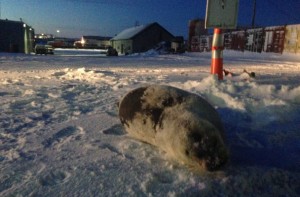
Alaska’s marine mammal population is stressed, according to the U.S. Marine Mammal Commission. One member of the federal agency will share new research on marine mammal health and discuss how the commission is helping conserve animals like walrus and seals on Monday in Nome.
“I’m going to focus mostly on harmful algal blooms and the effects that we know they have on marine mammals,” said Dr. Frances Gulland, a member of the commission and a senior scientist at the Marine Mammal Center in Sausalito, California. “I’ll also talk a little bit about ship strikes on whales and then briefly on the seal sickness outbreak from 2011.”
Seal sickness was first reported in 2011, and Gulland said the disease is still a problem. It causes patchy coats, sores, and sluggish behavior in seals.
“At this point, we know that it’s probably a number of different factors influencing the hormonal system of the seals,” she said. “But the single main cause is still not clear.”
The Marine Mammal Commission is studying changing Arctic conditions, which affect subsistence hunting. Gulland is among a group of scientists in Nome this week.
“I work in the Lower 48 on marine mammal health, but I don’t live here,” she said. “So I’d actually love to learn something from the local community that will help us understand more the changes that we’re seeing.”
Gulland will give a talk Monday night on changes in marine mammal health as part of the University of Alaska Fairbanks’ Northwest Campus Strait Science Series.
Laura Kraegel covers Unalaska and the Aleutian Islands for KUCB . Originally from Chicago, she first came to Alaska to work at KNOM, reporting on Nome and the Bering Strait Region. (laura@kucb.org / 907.581.6700)




